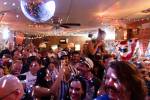UNLV students’ gadget ideas going to market
We'll get to the glowing electric beer pong in a minute, but we've got to talk to the MBA students about scuba gear first.
A little background:
For a decade now, engineering students at UNLV have been required to conceive of, design and build a product that should, in theory, sell in the marketplace.
Recent past projects have included solar-powered road signs, motorcycle headlights that see around corners, and an automatic wine bottle opener. Most of it was really cool stuff.
But none, not a single one, ever went to market. These are engineers, after all. Their expertise is in designing and building things, not so much in consumers, marketing and finance.
So, last year, the dean of the engineering college, Rama Venkat, pitched a partnership with the business college. Business students would choose among the engineering projects and write a business plan for one as part of a course. Many of the engineering projects get selected for the pitch, though some don't.
In the partnership's first year, an engineering team produced a tote for hauling scuba gear around. Basically, it was a dolly with cutouts for scuba tanks.
The business plan written by the MBA students went on to win a Southern Nevada competition that brought with it $50,000. Then they won $20,000 more in a statewide competition. They're about to enter a three-state competition that could bring in more prize money.
The MBA students have formed a corporation now, Scuba Solutions, taken on a designer with experience in the field, and say they're about to latch on to an investor. All of the prize money is in the corporation's bank account.
This has all happened since last fall.
"We're passionate about being entrepreneurs," said Griffin Owings, 28, the company's CEO and, as of today, a graduate of UNLV with a Master of Business Administration degree.
"It's what we want to do," said Chris Powell, 27, the chief technology officer, also graduating with his MBA today.
The original engineering students, Powell and Owings said, are not involved in the company anymore. They're still negotiating the terms, they said.
But the business could be poised to take off. They've got warehouse space, a small office, and plans for all kinds of new products. They don't plan on doing retail, instead focusing on manufacturing and distributing scuba gear.
They figure they need about $150,000 to get the first two products to market. There's a quick release fastener for scuba tanks, for starters. They're also working on other stuff they hope to manufacture and sell one day.
Paul Jarley, dean of the business college, said launching enterprises like Scuba Solutions is the whole point of the partnership between the engineering and business colleges.
"Commercially innovative projects come from people with different backgrounds talking to each other," he said. "Innovation happens by getting people out of their comfort zones."
Nick Fiore, director of the Mendenhall Innovation Program in the engineering college, said two patents have now come out of recent senior design projects. The first was for a component within a target shooting rifle.
The second, a provisional patent, was awarded this week to a team that presented its project Friday with 17 other teams of students at the twice-a-year senior design competition.
The grand prize winner Friday was a project -- by Charbel Azzi, Steven Correia and Jorge Reynaga -- called Smell-O-Vision, which is pretty much what it sounds like. It's designed primarily for movie theaters.
The provisionally patented product was the MASH tool, basically a manual jackhammer or ground compactor (MASH stands for Manually Actuated Spring Hammer). It's really just a long steel tube with a spring and a hammer inside and a spike or a flat piece attached to the bottom.
It's so strong it'll break up concrete or mash asphalt into a pothole with no external power source. It could be marketed to small businesses and homeowners.
Nic Smith, one of the team members, said they weren't able to partner with the MBA students because of scheduling conflicts, but the team hopes to either manufacture and sell the tool, or sell off the rights for a pile of cash.
"We would love to make money on this project," he said.
Which is, let us face it, the perfect segue to the beer pong guys. They are destined to make millions on this idea, despite the fact that they, too, weren't able to get the MBA students on board because of scheduling problems.
Beer pong is a drinking game. Team members toss pingpong balls into cups of beer. They drink. There are other rules, .
The point is, said team member Gerold Agustin, that a bunch of UNLV engineering students were sitting around one night last fall playing beer pong, and the deadline to submit their senior design project idea was fast approaching.
They'd already had some ideas shot down; they really liked one about developing a solar-powered bicycle, but it was a no-go.
So anyway, somebody said "What about beer pong?" As in, let's use these engineering skills we're paying thousands of dollars in tuition for to design a high-tech beer pong game.
What college student is going to say no to that? Not these guys.
They got themselves a table. They put all kinds of electronic wizardry into it, and they came up with a game where these fancy sensors light up in a glowing blue when there's a cup of beer on them. The lights turn red when a ball has landed in the cup.
They envision seeing these games in bars, right next to the foosball and the pool tables, maybe.
"We expect," the students wrote in their project's abstract, "this will bring a new excitement to the game of beer pong."
Spoken like true engineers. Maybe they'll still be able to hook up with the marketing guys.
Contact reporter Richard Lake at rlake@reviewjournal .com or 702-383-0307.























